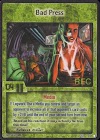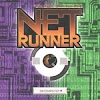Fantasy
Flight Games recently announced the upcoming release of Android:
Netrunner,
an asymmetrical Living
Card Game™ (LCG)
for two players that has its foundations in the high-stakes
cyberstruggles of Richard Garfield’s classic card game, Netrunner.
In the 1990s, Netrunner’s
dynamic, asymmetrical game play earned it a unique position among the
early wave of customizable card games. Even so, despite the game’s
strengths, it didn’t survive the turbulent environment of the late
1990s and went out of print after just two expansions.
Why,
then, did Fantasy Flight Games recently announce its plans to remake
this classic, giving it new life as Android: Netrunner?
There are three main reasons:
- The original iteration of Netrunner, along with our decade of experience publishing card games such as A Game of Thrones: The Card Game, has provided us with valuable lessons that we are able to apply to Android: Netrunner.
- Finally, we believe the LCG model offers more promise for the future of Netrunner than the collectible model did. For more on that point, read on.
The
Living Card Game™ Model
Redesigning Netrunner in
the LCG format does more for it than simply remove the blind buy
purchases and rare chasing that burn out some players and turn others
away even before they start. The LCG model opens new design concepts.
When
you remove the concept of card rarity, you aren’t compelled to
design rarer copies of other, more common cards that do effectively
the same thing. You can remove the clutter of multiple cards all
fulfilling roughly the same goal. The focus can shift, instead,
toward the variety of cards available, making sure players will have
plenty of options to explore for deck design. Throughout the years,
we’ve seen again and again that “constraint breeds creativity.”
With that in mind, we’ve introduced distinct factions to the game,
each with unique strengths and weaknesses; this will bolster the meta
and benefit the game’s long-term viability. We’ve also created
some deck-building limitations (such as a maximum of three copies of
any one card per deck) that leave the heart of the game intact but
promote creative exploration and deck diversity.
The
LCG model also presents other design advantages. A designer can more
clearly design toward the overall gaming experience, including how
cards lend themselves to different styles of play or an average game
duration. He can redirect some of the energy from a focus on the
variable power levels of a player’s cards toward the unique feel
they bring to the table as they enter play. Is each distinct? Is each
worth playing?
Notes
from the Developer
Lead
developer Lukas Litzsinger shares some insights into the work he did
in remaking Android: Netrunner as an LCG:
When
I first found out I would be working on the reimagining of Netrunner,
I was ecstatic. Not only was it designed by Richard Garfield himself,
but it was wrapped up in cyberpunk. Put simply, it was one of the
holy grails of collectible gaming.
There
is always a danger when approaching a project of this sort. You can
change nothing, and find that what worked fifteen years ago might not
work for new players. Conversely, you can change too much, and find
that at a certain point along the way the game has lost its special
spark. We wanted to make sure that Android: Netrunner would
respect the core of the old game while giving it a strong LCG
identity.
When
it comes down to it, Android: Netrunner is a game
built on risk-taking and bluffing. The heart of both the original
game and Android: Netrunner is the idea of the
“run.” We wanted to make sure that when updating the game we
always kept the focus on the run. Everything else is secondary.
Thanks,
Lukas!
Check
back later this week, when we’ll post an interview with Richard
Garfield himself in which he shares his insights into the development
of Android:
Netrunner.
Then, visit often for in-depth previews of the game’s
mechanics. The
runs begin at Gen Con Indy 2012!






0 Comments